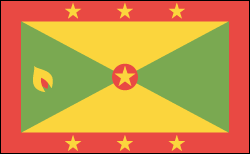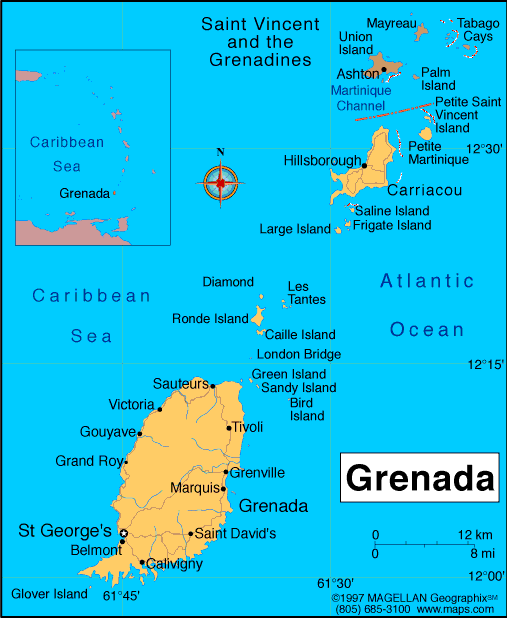GRENADA

Geography: Grenada (the first “a” is a long vowel) is the most southerly of the Windward Islands, about 100 mi (161 km) from the Venezuelan coast. It is a volcanic island traversed by a mountain range, the highest peak of which is Mount St. Catherine (2,756 ft; 840 m).
Government: Constitutional monarchy. A governor-general represents the sovereign, Elizabeth II.
History: The Arawak Indians were the first to inhabit Grenada, but they were all eventually massacred by the Carib Indians. When Columbus arrived in 1498, he encountered the Caribs, who continued to rule over the island for another 150 years. The French gained control of the island in 1672 and held on to it until 1762, when the British invaded. Black slaves were granted freedom in 1833. After more than 200 years of British rule, most recently as part of the West Indies Associated States, Grenada became independent on Feb. 7, 1974, with Eric M. Gairy as prime minister.
In 1979, the Marxist New Jewel Movement staged a coup, and its leader, Maurice Bishop, became prime minister. Bishop, a protégé of Cuba's President Castro, was killed in a military coup on Oct. 19, 1983.
Government: Constitutional monarchy. A governor-general represents the sovereign, Elizabeth II.
History: The Arawak Indians were the first to inhabit Grenada, but they were all eventually massacred by the Carib Indians. When Columbus arrived in 1498, he encountered the Caribs, who continued to rule over the island for another 150 years. The French gained control of the island in 1672 and held on to it until 1762, when the British invaded. Black slaves were granted freedom in 1833. After more than 200 years of British rule, most recently as part of the West Indies Associated States, Grenada became independent on Feb. 7, 1974, with Eric M. Gairy as prime minister.
In 1979, the Marxist New Jewel Movement staged a coup, and its leader, Maurice Bishop, became prime minister. Bishop, a protégé of Cuba's President Castro, was killed in a military coup on Oct. 19, 1983.

Map of Grenada
Sovereign: Queen Elizabeth II
(1952)
Governor-General: Cécile La Grenade (2013)
Prime Minister: Keith Mitchell (2013)
Land area: 131 sq mi (339 sq km)
Population (2014 est.): 110,152 (growth
rate 0.52%); birth rate: 16.3/1000; infant mortality rate: 10.5/1000;
life expectancy: 73.8
Capital and largest city (2011 est.):
St. George's, 41,000
Monetary unit: East Caribbean
dollar
Languages:
English (official), French patois
Ethnicity/race:
black 82%, mixed black and European 13%,
European and East Indian 5%, and trace of Arawak/Carib
Amerindian
Religions:
Roman Catholic 53%, Anglican 13.8%, other
Protestant 33.2%
National Holiday:
Independence Day, February 7
Literacy rate: 96% (2003 est.)
Economic summary: GDP/PPP (2013
est.): $1.458 billion; per capita $13,800. Real growth rate: 0.8%. Inflation: 2.4%. Unemployment: 33.5% (2013).
Arable land: 8.82%. Agriculture: bananas, cocoa, nutmeg,
mace, citrus, avocados, root crops, sugarcane, corn, vegetables.
Labor force: 59,900 (2013); services 69%, agriculture 11%,
industry 20% 2008 est.). Industries: food and beverages,
textiles, light assembly operations, tourism, construction.
Natural resources: timber, tropical fruit, deepwater harbors.
Exports: $40.5 million (2012 est.): bananas, cocoa, nutmeg,
fruit and vegetables, clothing, mace. Imports: $297 million
(2012): food, manufactured goods, machinery, chemicals, fuel.
Major trading partners: Nigeria, St. Lucia, Antigua and
Barbuda, Saint Kitts and Nevis,U.S., Dominica, Switzerland, Trinidad and Tobago, China (2012).
Member of Commonwealth of Nations
Communications: Telephones: main lines
in use: 28,500 (2012); mobile cellular: 128,000 (2012). Broadcast media:the
Grenada Broadcasting Network, jointly owned by the government and the
Caribbean Communications Network of Trinidad and Tobago, operates a TV
station and 2 radio stations; multi-channel cable TV subscription
service is available; a dozen private radio stations also broadcast
(2007) Internet
hosts: 80 (2012). Internet users: 25,000 (2009).
Transportation: Railways: 0 km.
Roadways: total: 1,127 km; paved: 687 km; unpaved: 440 km
(1999 est.). Ports and harbors: Saint George's.
Airports: 3 (2013).
International disputes: none.
-------------------- o --------------------
No comments:
Post a Comment